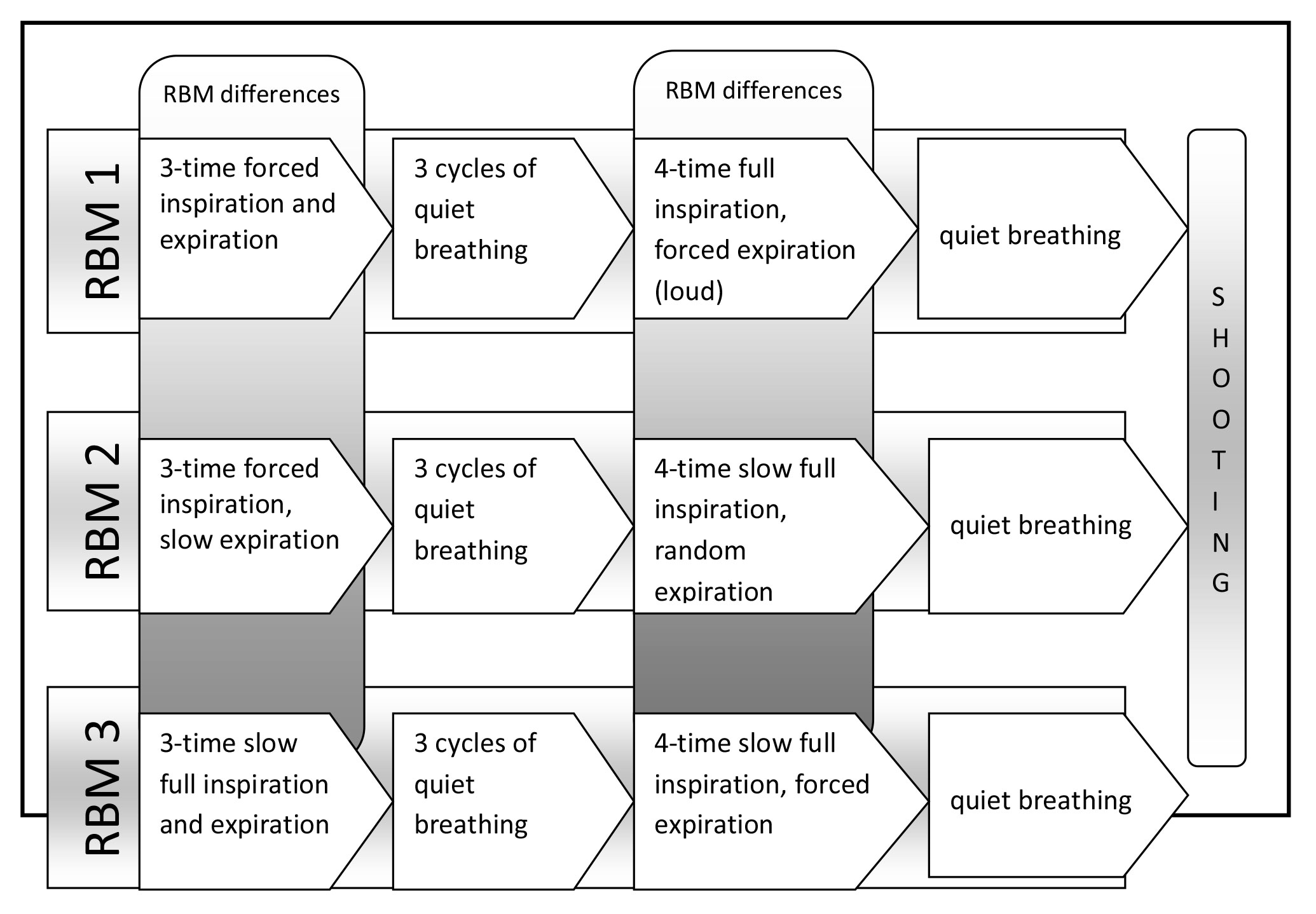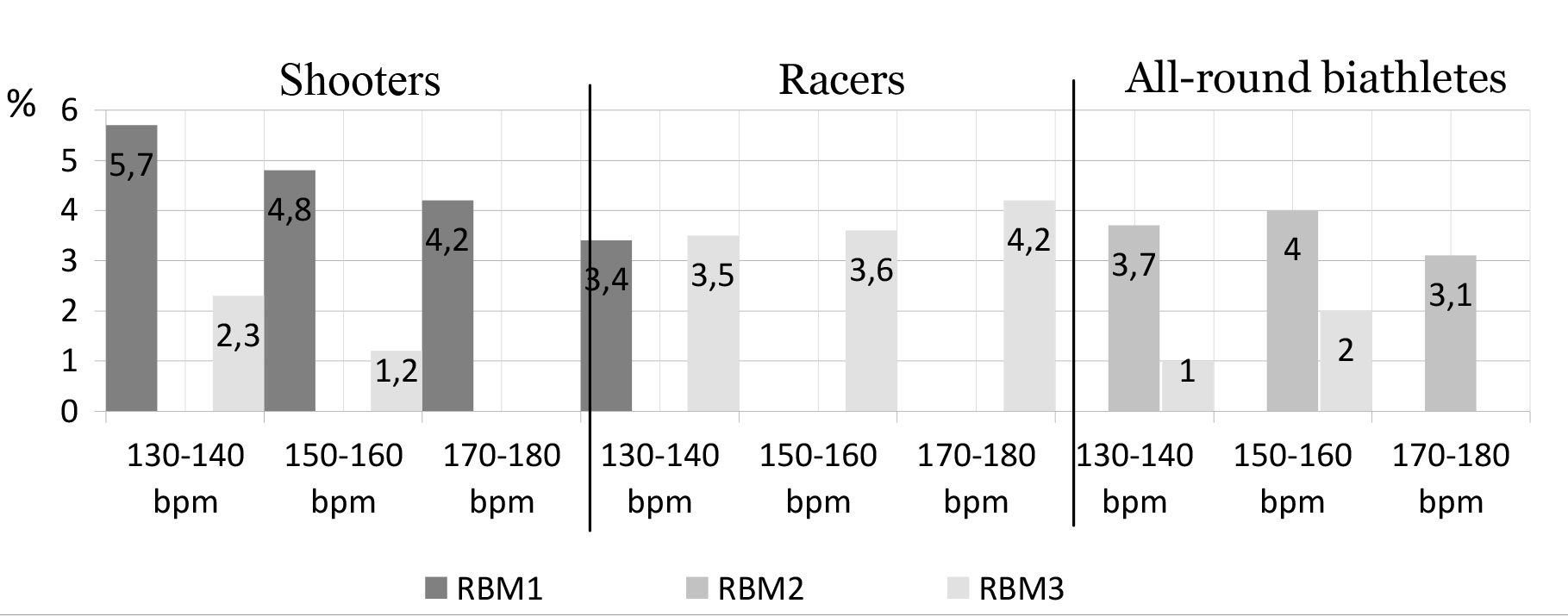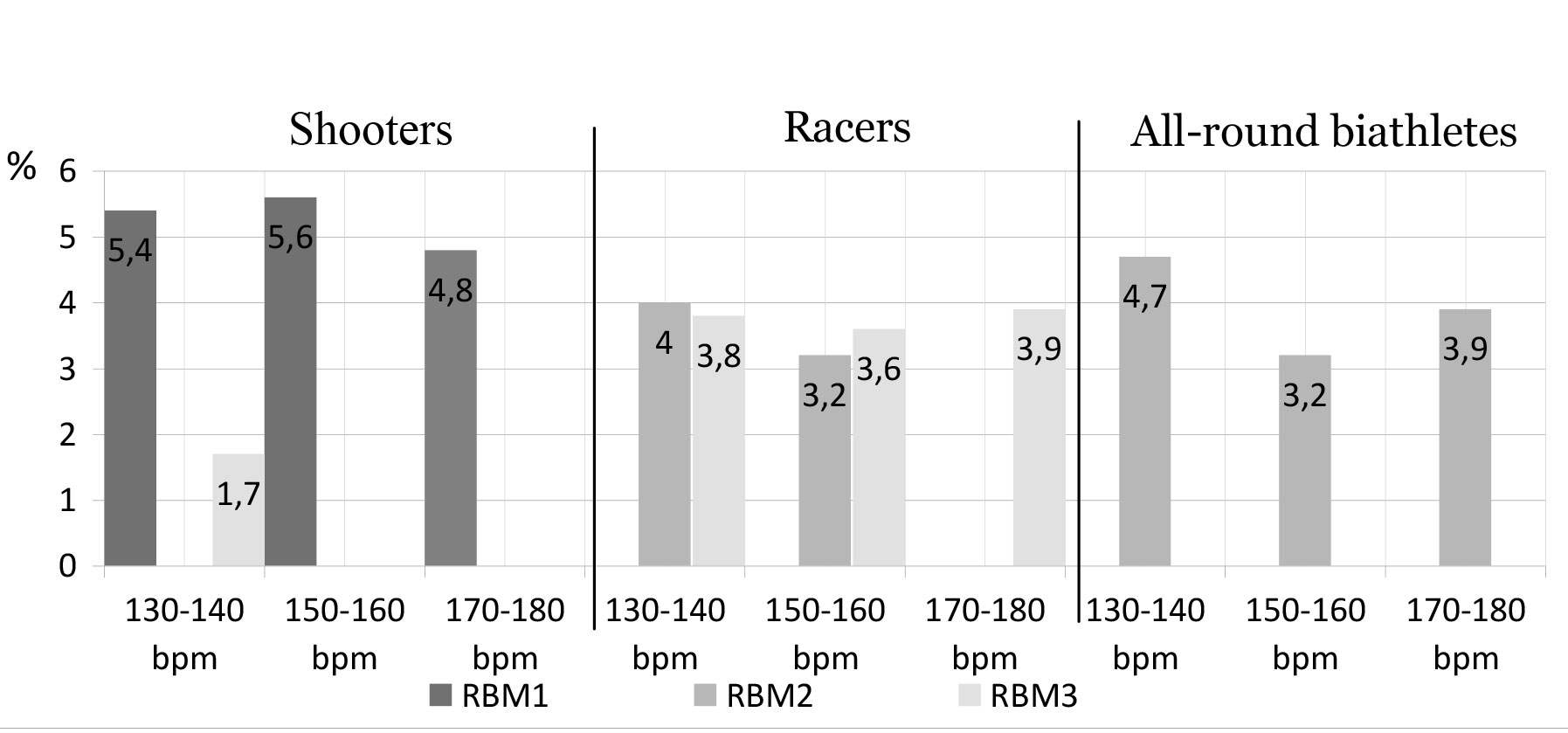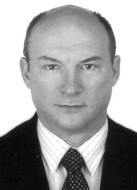Regulated breathing modes in pre-season shooting practices of skilled biathletes
Фотографии:
ˑ:
Dr.Hab. V.V. Farbey1
Postgraduate E.G. Zhevlakov1
Postgraduate K.G. Klimushin1
Postgraduate M.V. Kurochkin1
1Herzen State Pedagogical University of Russia, St. Petersburg
Keywords: competitive fitness types in biathlon, shooting training, breathing exercises, regulated breathing modes.
Introduction. The structure of competitive activity of skilled biathletes imposes strict requirements for the shooting exercise performance under strenuous physical loads.
Shooting requires of biathletes improvement of the skill to align their breathing rhythm and motor actions on the firing line [1, 4-6].
In the theory and practice of physical culture and sports, one can find data on the use of breathing exercises in physical training of athletes with different skill levels in different sports [2, 3, 7, 8]. However, the data on the use of breathing exercises in physical training of biathletes, neither scientific substantiation of the application of such exercises are lacking in modern literature [1, 6].
Objective of the study was to check the effects of RBM on the quality of shooting of biathletes of different competitive fitness types.
Methods and structure of the study. It was assumed that shooting performance of biathletes of various competitive fitness could be improved through regulated breathing modes (RBM) by means of aligning their breathing rhythms and motor actions when approaching the firing line and on the line, which would ensure the speed and quality of shooting during functional shifts.
Subject to the shooting practices testing experiment were 26 skilled biathletes of the Herzen SPUR team, SSHS in winter sports, Olympic Reserve Academy 2, SCYSOR of Vyborg district of Saint Petersburg. The athletes were split into 3 experimental groups (EG) with regard to their competitive fitness including: 8 shooters, 9 racers and 9 all-round biathletes. The athletes were trained as required by the experimental training model with application of the following breathing control practices (BCP): 1 - resting practices; 2 - breath-holding; 3 - forced breathing; 4 - zeroing-in breathing; 5 - high-rifle-support; 6 - mirror-assisted zeroing-in; and 7 - close-up (relaxation) breathing practices.
BC were approbated in 3 EG: "all-round biathletes", "shooters", "racers" subjected to physical loads of various intensity. The reference group (RG) was trained using the conventional method.
Results and discussion. The experimental validation of the effects of BC on shooting performance in shooting tests with physical loads of various intensity revealed the ambiguous influence of BC on the quality of shooting of biathletes of various competitive fitness types (Figure 1).
The best shooting results were demonstrated by the athletes who had applied BC: № 3 and 5 - "shooters"; № 4 - "racers"; № 4 and 6 "all-round biathletes".

Fig. 1. Regulated breathing modes content
Based on the content of the most effective BCP, we have developed 3 RBM patterns used when approaching the firing line (100 m to the line), which combined different breathing exercises:
1) 3-time forced inspiration and expiration, followed by 3 cycles of quiet breathing, and then 4-time full inspiration, forced expiration, followed by quiet breathing;
2) 3-time forced inspiration, slow expiration, followed by 3 cycles of quiet breathing, and then 4-time slow full inspiration, forced loud expiration, followed by quiet breathing;
3) 3-time slow full inspiration and expiration, followed by 3 cycles of quiet breathing, and then 4-time slow full inspiration, forced expirations, followed by quiet breathing (see Fig. 1).
RBM were tested in all the groups ("all-round biathletes", "shooters", "racers") in various intensity zones; the results were fixed in the control shooting tests using the following simulators: coordination simulators; ski machines; treadmill; cycle ergometer; conduct-of-fire trainers.
The analysis of shooting performance using RBM when approaching the firing line revealed a significant increase in the results (p<0.05): when shooting from lying and standing positions in terms of functional shifts of various intensity using RBM1 in the "shooters" group - by 6.1%, when shooting from the lying position using RBM3 - by 4.1%; in the "all-round biathletes" group using RBM2 - by 5.7%; in the "racers" group using RBM3 - by 4.4%. There were no changes in the rest of the indicators (p>0.05).
Based on these data, in order to enhance shooting performance in biathlon training, we have suggested that effective BCP and RBM should be used during training sessions and competitions taking into account the competitive fitness levels in biathlon: "shooters" - RBM1; "racers" - RBM3; "all-round biathletes" - RBM2.
The experimental verification of the effects of BCP on the shooting indicators of biathletes of various competitive fitness levels revealed that with the heart rate of 130-140 bpm a significant increase of shooting quality was observed at p<0.05: "shooters" – when shooting from the lying and standing positions using RBM1 and 3; "racers" – lying, RBM1; standing, RBM2; lying and standing, RBM3; "all-round biathletes" – lying, RBM3; lying and standing, RBM2 (Fig. 2, 3).
Under strenuous load, when the heart rate was 150-160 bpm, we observed a statistically significant increase in shooting results at p<0.05: in the "shooters" group – when shooting from the lying and standing positions using RBM1; lying, RBM3; "racers" - standing, RBM2; lying and standing, RBM3; "all-round biathletes" – lying, RBM3; lying and standing, RBM2.
With the heart rate of 170-180 bpm, a statistically significant increase of shooting quality was observed at p<0.05: "shooters" – when shooting from the lying and standing positions using RBM1; lying, RBM3; "racers" - lying and standing, RBM3; "all-round biathletes" - lying and standing, RBM2.
The analysis of shooting performance using different RBM in terms of functional shifts of various intensity revealed increased shooting results at p<0.05: in the group of "shooters" when shooting from the lying and standing positions in all intensity modes using RBM1 - by 6.1%; from the lying position using RBM3 - by 4.1%; in the group of "all-round biathletes" when using RBM2 - by 5.7%; in the group of "racers" using RBM3 - by 4.4%.

Fig. 2. Dynamics of shooting indicators in biathletes of different competitive fitness levels when shooting from lying position using different RBM

Fig. 3
Conclusions. The use in the biathlon training of breathing exercises of various orientation with varied-intensity loads made it possible to identify regulated breathing modes to be applied by athletes of different competitive fitness levels.
The shooting results in all intensity zones were found to be significantly affected by RBM: "shooters" - RBM1 and 3; "racers" - RBM3; "all-round biathletes" - RBM2. The use of RBM in the process of training of skilled biathletes, with due regard to their competitive fitness type, made it possible to improve the effectiveness of the shooting training.
References
- Zrybnev N.A. Osobennosti dykhaniya biatlonista vo vremya lyzhnoy gonki i strelby [Specific breathing of biathlete during ski race and shooting]. Uchenye zapiski un-ta im. P.F. Lesgafta, 2015, no. 3 (121), pp. 39-42.
- Mikhailov A.S. Funktsionalno-fizicheskaya podgotovka kikbokserov s primeneniem razlichnykh rezhimov dykhatelnykh uprazhneniy. Avtoref. dis. kand. ped. nauk [Functional physical training of kickboxers using various breathing modes. PhD diss. abstract]. St. Petersburg, 2008, 23 p.
- Milodan V.A. Vliyanie reglamentirovannykh rezhimov dykhaniya na uvelichenie rabotosposobnosti v bege. Avtoref. dis. kand. ped. nauk [Influence of regulated breathing modes on increase of work capacity in running. PhD diss. abstract]. St. Petersburg, 2008, 23 p.
- Farbey V.V., Dunaev K.S. Tipologiya sorevnovatelnoy podgotovlennosti lyzhnikov-mnogobortsev v protsesse stanovleniya vysshego sportivnogo masterstva [Combined racing skiers' competitive fitness typing at sport mastery excellence stage]. Teoriya i praktika fiz. kultury, 2017, no. 3, pp. 73–75.
- Farbey V.V. Formirovanie tipa sorevnovatelnoy podgotovlennosti lyzhnikov-mnogobortsev na etapakh stanovleniya sportivnogo masterstva [Formation of type of competitive fitness in all-round skiers at sport mastery excellence stages]. Uch. zapiski un-ta im. P.F. Lesgafta, 2012, no. 3 (85), pp. 180-184.
- Farbey V.V., Zhevlakov E.G. , Klimushin K.G. et al Primenenie reglamentirovannykh rezhimov dykhaniya v strelkovoy podgotovke biatlonistov s razlichnym tipom sorevnovatelnoy podgotovlennosti [Regulated breathing modes in rifle training for biathletes with different types of competitive fitness]. Uchenye zapiski un-ta im. P.F. Lesgafta, 2017, no. 10 (152), pp. 277-281.
- Chemov V.V. Metodologicheskie i tekhnologicheskie osnovy integratsii dvigatelnykh zadaniy i reglamentirovannykh rezhimov dykhaniya ergogenicheskogo vozdeystviya v trenirovke kvalifitsirovannykh legkoatletov. Avtoref. dis. dokt. ped. nauk [Methodological and technological basics of integration of motor tasks and regulated breathing modes of ergogenic influence in training of skilled athletes. Author's abstract. dis. Doct. diss. abstract (Hab.)]. Volgograd: VSAPE publ., 2014, 48 p.
- Chuev V.A. Gipoksicheskie i relaksatsionnye sredstva trenirovochnykh vozdeystviy v podgotovke futbolistok. Dis. kand. ped. nauk [Hypoxic and relaxation training tools in women's football training process. PhD diss. abstract]. St. Petersburg, 2004, 157 p.
Corresponding author: g-ponomarev@inbox.ru
Abstract
The study gives theoretical grounds for application of regulated breathing modes in the skilled biathletes’ shooting practices to improve the shooting skills with account of the individual competitive predispositions.
Subject to the shooting practices testing experiment were 26 skilled biathletes including 8 shooters, 9 racers and 9 all-round biathletes. The athletes were trained as required by the experimental training model with application of the following breathing control practices: resting practices; breath-holding; forced breathing; zeroing-in breathing; high-rifle-support; mirror-assisted zeroing-in; and close-up (relaxation) breathing practices. The breathing practices were tested in the following Experimental Groups (EG): all-round EG, shooting EG and racing EG, in the varied-intensity training conditions; with the Reference Group trained as required the traditional training model. The breathing control model testing experiment showed its benefits as verified by the EG progress in the varied-intensity training conditions; and found the most efficient regulated breathing modes applicable in different competitive conditions.


